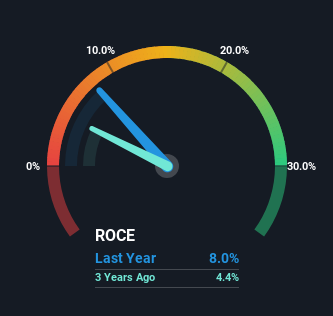The Returns At New Jersey Resources (NYSE:NJR) Aren't Growing
To find a multi-bagger stock, what are the underlying trends we should look for in a business? Ideally, a business will show two trends; firstly a growing return on capital employed (ROCE) and secondly, an increasing amount of capital employed. Ultimately, this demonstrates that it's a business that is reinvesting profits at increasing rates of return. In light of that, when we looked at New Jersey Resources (NYSE:NJR) and its ROCE trend, we weren't exactly thrilled.
Return On Capital Employed (ROCE): What Is It?
For those that aren't sure what ROCE is, it measures the amount of pre-tax profits a company can generate from the capital employed in its business. Analysts use this formula to calculate it for New Jersey Resources:
Return on Capital Employed = Earnings Before Interest and Tax (EBIT) ÷ (Total Assets - Current Liabilities)
0.08 = US$449m ÷ (US$6.3b - US$711m) (Based on the trailing twelve months to March 2023).
So, New Jersey Resources has an ROCE of 8.0%. On its own that's a low return, but compared to the average of 5.3% generated by the Gas Utilities industry, it's much better.
View our latest analysis for New Jersey Resources
Above you can see how the current ROCE for New Jersey Resources compares to its prior returns on capital, but there's only so much you can tell from the past. If you'd like, you can check out the forecasts from the analysts covering New Jersey Resources here for free.
What The Trend Of ROCE Can Tell Us
In terms of New Jersey Resources' historical ROCE trend, it doesn't exactly demand attention. The company has employed 71% more capital in the last five years, and the returns on that capital have remained stable at 8.0%. Given the company has increased the amount of capital employed, it appears the investments that have been made simply don't provide a high return on capital.
Our Take On New Jersey Resources' ROCE
Long story short, while New Jersey Resources has been reinvesting its capital, the returns that it's generating haven't increased. Unsurprisingly, the stock has only gained 15% over the last five years, which potentially indicates that investors are accounting for this going forward. Therefore, if you're looking for a multi-bagger, we'd propose looking at other options.
One more thing: We've identified 2 warning signs with New Jersey Resources (at least 1 which is significant) , and understanding them would certainly be useful.
For those who like to invest in solid companies, check out this free list of companies with solid balance sheets and high returns on equity.
Have feedback on this article? Concerned about the content? Get in touch with us directly. Alternatively, email editorial-team (at) simplywallst.com.
This article by Simply Wall St is general in nature. We provide commentary based on historical data and analyst forecasts only using an unbiased methodology and our articles are not intended to be financial advice. It does not constitute a recommendation to buy or sell any stock, and does not take account of your objectives, or your financial situation. We aim to bring you long-term focused analysis driven by fundamental data. Note that our analysis may not factor in the latest price-sensitive company announcements or qualitative material. Simply Wall St has no position in any stocks mentioned.
Join A Paid User Research Session
You’ll receive a US$30 Amazon Gift card for 1 hour of your time while helping us build better investing tools for the individual investors like yourself. Sign up here

